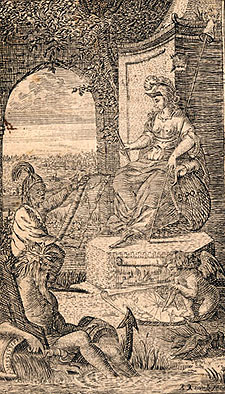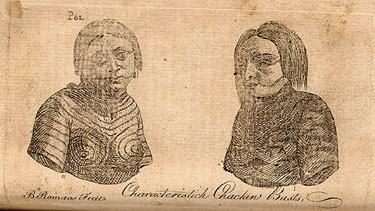 |
| Title page of Romans's, Natural History of Florida |
Born in the Netherlands and raised in England, Bernard Romans (ca.1720-ca.1784) came to America in about 1757 as a junior surveyor in the British service, becoming one of the pioneering cartographers of the American southeast. Assigned to duty in Saint Augustine, East Florida, before 1760, Romans soon began to rise through the ranks of the British engineering establishment. In 1766, he was appointed deputy surveyor in Georgia, and in the following year, was made deputy surveyor for the entire Southern District, reporting to the German-born Gerard de Brahm.
Like many military officers in the hinterlands, Romans sought to enrich himself through the acquisition of land and slaves, but he never neglected his surveying duties. He made the first maps of Pensacola Harbor, Tampa Bay, and Mobile Bay, and along with David Tait and George Gauld (who prowled the coastal regions), he was responsible for mapping most of the interior of West Florida between 1770 and 1772.
 |
| Frontispiece of Romans's, Natural History of Florida |
Romans' maps abound in details about the productivity of the soil, the locations of Indian towns and villages, European settlements, and the flora and fauna. As he prepared them, he may already have had in mind the prospect of producing an accompanying volume on colonial natural history. The British civil and military establishment prized
Romans' maps and charts for their accuracy, and they demonstrated their support in the clearest way possible by the standards of the day: financially. The Governor of West Florida recommended that Romans receive a pension to keep him in the south, and in 1773, Whitehall rewarded him with a pension of £50 in recognition of "his care and skill in the collection of rare and useful products in physics and botany."
With pension in hand, and pecuniary concerns allayed, Romans did just what his superiors hoped he would not: he left. Heading to New York, Romans scoured the colonies from Boston to Philadelphia for supporters to help finance the publication of his Florida maps and
Concise History. With the assistance of a handful of patrons and a small network of learned societies, Romans enlisted subscribers to his publications, in the process becoming better known to the American Philosophical Society. He was elected a member in January, 1774, one year before the first volume of his book appeared in print. Although this first volume was reissued in 1776, the second volume never appeared.
Romans' Concise History is neither the most learned nor most comprehensive work on the subject, nor is it the most cogent. With his narrative rambling over East Florida (most of the peninsula), West Florida (the panhandle and much of the current gulf states), and parts of Georgia, Romans wrote not only to describe the natural features of the region, but to encourage emigration and official interest. Anecdotal, rather than analytical, he defended the salubrity of the climate, the productivity of the soil, and the potential for profitable development, singling out indigo as the most lucrative and cotton as a close second.
 |
Choctaw women
(click to read Romans's comments on Indians) |
Necessary to the development of the region, in Romans' opinion, was slavery. Disputing those Enlightened individuals who emphasized the role of the environment in shaping biology and culture, Romans became an early advocate of the innate biological inferiority of Africans and Indians alike. The discussion of Indian cultures occupied a large portion of his
Concise History, and despite first hand knowledge of the Choctaws, Chickasaws, Creeks, Romans was disinclined to acknowledge the high level of civilization among them. Reflecting his opinions, Romans wrote that he disliked the term "Indian," preferring instead the French term,
sauvage, because "the manners of the red men are in every respect such as betray that disposition." In his mind, Indians are "not only rude and cultivated, but incapable of civilization," and despite being "well made both men and women," they were filthy in habit and "addicted to lying in a high degree."
The differences between races, Romans asserted, were more than cultural, they cut to the bone. Africans "are of a difference species" from whites, he insisted: "Anatomy has taught us, that the bone of a Negroe's skull, is always black, that besides the Tunics of which our skins are composed, they have an additional one, constituting of numerous vessicles, filled wish [sic] a black ink-like humour." Prefiguring later polygenic arguments, Romans suggested that "there were as many Adams and Eves (every body knows these names to have an allegorical sense) as we find different species of the human genus," implicitly denying Africans and Indians their humanity and justifying their subordination.
 |
Creek chief
(click to read Romans's comments on Indians) |
That the second volume of the
Concise History never appeared was, in part, a result of timing. Writing just as the revolutionary tide was cresting, Romans was able to
secure only 199 subscribers, and the number of additional purchasers was surely hampered by its date of completion: April 25, 1775, six days after Lexington and Concord. Romans himself was diverted by events, and at the expense of his pension, joined the American military effort. On April 29, he volunteered his services as an engineer during the expedition on Fort Ticonderoga, and continuing to serve with the American forces for four or five more years. His eventual fate, however, is uncertain. In one version, he was said to have been captured at sea in 1780 and held as a prisoner of war in Jamaica until 1784, dying on the return home; another version suggests he was captured at Stony Point in 1779, held in England, and murdered for his money while returning to the United States in 1784.
The APS copy of Romans' Concise History was presented to the Society by it librarian, John Vaughan in 1806.




